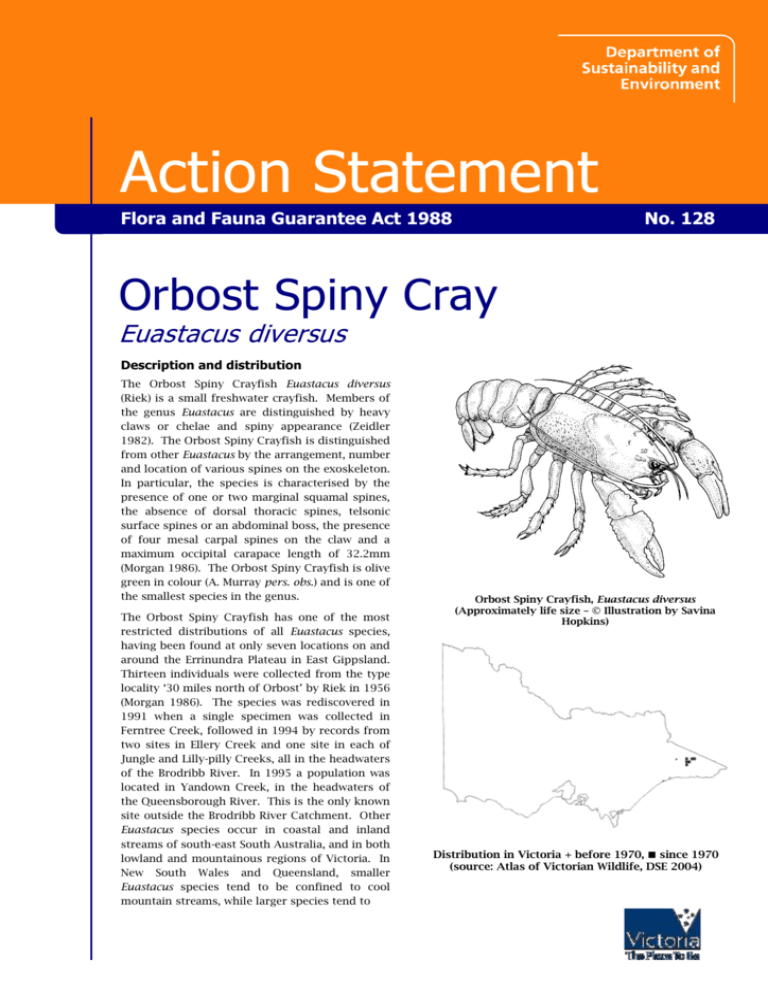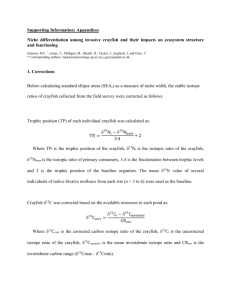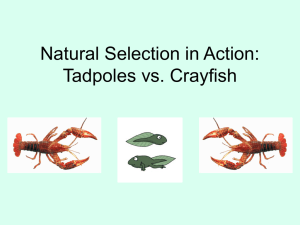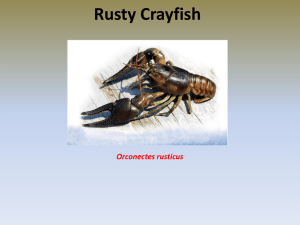Orbost Spiny Crayfish (Euastacus diversus) accessible
advertisement

Action Statement Flora and Fauna Guarantee Act 1988 No. 128 Orbost Spiny Cray Euastacus diversus Description and distribution The Orbost Spiny Crayfish Euastacus diversus (Riek) is a small freshwater crayfish. Members of the genus Euastacus are distinguished by heavy claws or chelae and spiny appearance (Zeidler 1982). The Orbost Spiny Crayfish is distinguished from other Euastacus by the arrangement, number and location of various spines on the exoskeleton. In particular, the species is characterised by the presence of one or two marginal squamal spines, the absence of dorsal thoracic spines, telsonic surface spines or an abdominal boss, the presence of four mesal carpal spines on the claw and a maximum occipital carapace length of 32.2mm (Morgan 1986). The Orbost Spiny Crayfish is olive green in colour (A. Murray pers. obs.) and is one of the smallest species in the genus. The Orbost Spiny Crayfish has one of the most restricted distributions of all Euastacus species, having been found at only seven locations on and around the Errinundra Plateau in East Gippsland. Thirteen individuals were collected from the type locality ‘30 miles north of Orbost’ by Riek in 1956 (Morgan 1986). The species was rediscovered in 1991 when a single specimen was collected in Ferntree Creek, followed in 1994 by records from two sites in Ellery Creek and one site in each of Jungle and Lilly-pilly Creeks, all in the headwaters of the Brodribb River. In 1995 a population was located in Yandown Creek, in the headwaters of the Queensborough River. This is the only known site outside the Brodribb River Catchment. Other Euastacus species occur in coastal and inland streams of south-east South Australia, and in both lowland and mountainous regions of Victoria. In New South Wales and Queensland, smaller Euastacus species tend to be confined to cool mountain streams, while larger species tend to Orbost Spiny Crayfish, Euastacus diversus (Approximately life size – © Illustration by Savina Hopkins) Distribution in Victoria + before 1970, since 1970 (source: Atlas of Victorian Wildlife, DSE 2004) occur at lower altitudes (Morgan 1983, 1997). Most species of Euastacus are moderate burrowers, seeking refuge under rock ledges and amongst submerged, in-stream tree roots (Zeidler 1982). pebbles or gravel, and abundant instream debris (logs and other vegetation), flowing through wet or damp forest or rainforest. The diet of spiny freshwater crayfish consists primarily of aquatic and semi-aquatic vegetation, benthic invertebrates (Goddard 1988), fungi and bacteria found in rotting detrital matter (DCE 1992). Invertebrate species which have a limited distribution are vulnerable to localised environmental perturbations (Williams 1990). Localised catastrophic events, such as an extended drought or large sediment pulse could drastically effect populations of the Orbost Spiny Crayfish. Roads across or along-side streams are the most likely potential source of a sediment pulse. Roading can cause an increase in sedimentation immediately downstream of the roadworks, resulting in a decline in the quality of both the water and the substrate (Koehn and O'Connor 1990). Current conservation status Horwitz (1990b)..................................................... rare The Orbost Spiny Crayfish has been listed as a threatened taxon under the Flora and Fauna Guarantee Act 1988. The Orbost Spiny Crayfish is considered threatened primarily because of its restricted distribution (known only from five small streams), its small population size (which is suspected from the limited number of specimens collected to date), the lack of ecological and biological information on it, and the possibility of detrimental habitat disturbance occurring as a result of forest management activities. In its final recommendations the Scientific Advisory Committee (SAC 1992) determined that the Orbost Spiny Crayfish is: significantly prone to future threats which are likely to result in extinction, and very rare in distribution. terms of abundance or Major Conservation Objectives Protect the in-stream and riparian habitat of the known populations of Orbost Spiny Crayfish. Prevent decline of the Orbost Spiny Crayfish within its natural distribution. Determine the distribution and abundance of the Orbost Spiny Crayfish. Management Issues Ecological issues specific to the taxon The distribution and abundance of the Orbost Spiny Crayfish is not well documented, and is based on 13 confirmed records (DSE 2004) and an inadequately recorded type locality (Morgan 1986). It is not known if the distribution of the Orbost Spiny Crayfish has changed since European settlement. The biology of this species is poorly known, and the environmental parameters under which it exists are not understood. Streams in the range of the species are cool, perennial and highly oxygenated, with a complex bed of cobbles, Threatening processes An incremental decline in habitat quality may result in the decline of the Orbost Spiny Crayfish. The adverse effects of habitat modification upon freshwater crayfish have been demonstrated in Europe and North America (Westman 1985). Geddes (1990) attributes the decline of the River Murray Crayfish E. armatus to changes in flow regime, stream morphology, productivity, water quality and sediment characteristics, with deoxygenation suspected as a major factor. Timber harvesting, which occurs in several of the catchments inhabited by the crayfish, has the potential to affect detrimentally crayfish populations by altering the run-off and flow characteristics of the stream, the amounts of organic debris entering the stream, the temperature regimes, the amount and rate of sediment entering the stream, and by increasing primary productivity in the stream, with each factor liable to be more acute the closer the logging activity comes to the waterway (Horwitz 1990b). However, the Code of Forest Practices for Timber Production (NRE 1996) is designed to minimise these potential threats. Following harvesting, it is current practice to carry out regeneration burns to create a seedbed for eucalypts. Burning the riparian vegetation can reduce its effectiveness as a runoff filter, resulting in an increase in the amount of nutrients and sediment entering the waterway. Loss of the riparian vegetation also results in an increase in both the light intensity and temperature within the stream, changes which generally reduce the suitability of streams as habitat for Euastacus species. The long-term changes in catchment hydrology following the harvesting of older multi-aged forest and regeneration with even-aged regrowth forest have been little studied. In situations 2 where a high proportion of a catchment has been converted to regrowth, streams may temporarily become less suitable as habitat for some aquatic species, especially during drought. Such hydrological changes may result in a temporary reduction in the area of suitable habitat available to the Orbost Spiny Crayfish. The introduction of exotic biota could also be a threat due to predation, competition, or the spread of disease (Horwitz 1990b). The introduced Brown Trout Salmo trutta, occurs in the Brodribb River system, and predation by this species may have a detrimental impact on populations of the crayfish. Populations of Orbost Spiny Crayfish may be threatened by over-collection. Whilst collection of specimens for confirmation of identity may be necessary at new sites, this practice should be otherwise avoided. Appropriate survey techniques include the use of baited traps, in which crayfish can be trapped alive and released, active searching, either at night using a spotlight, or during the day searching amongst instream woody debris and rocky substrate, and electrofishing (the use of electricity to stun fish and macroinvertebrates). Wider conservation issues The protection of streams inhabited by Orbost Spiny Crayfish will also benefit other resident species of aquatic flora and fauna (Blyth and Jackson 1985). Several fish species which are considered threatened in Victoria inhabit the catchments in which the Orbost Spiny Crayfish occurs. These include the Australian Grayling Prototroctes maraena (vulnerable), the Pouched Lamprey Geotria australis (rare), the Broad-finned Galaxias Galaxias brevipinnis (rare), and the Freshwater Blackfish Gadopsis marmoratus (status insufficiently known) (Raadik 1992). Protection of the riparian strip along streams inhabited by the Orbost Spiny Crayfish will also provide habitat for a number of rare or threatened (DSE 2003) birds and mammals, including the Spot-tailed Quoll Dasyurus maculatus (vulnerable), Long-footed Potoroo Potorous longipes (endangered), the Powerful Owl Ninox strenua (rare), and the Sooty Owl Tyto tenebricosa (rare). Twenty-four species of freshwater crayfish species in Australia are considered rare or threatened (Horwitz 1990b), mainly due to their confined geographic distributions (Williams 1990). Monitoring the effectiveness of the measures designed for the Orbost Spiny Crayfish may provide guidance for the conservation of other freshwater crayfish species. Previous Management Action A number of surveys have been carried out in the waterways in the presumed range of the Orbost Spiny Crayfish between 1986 and 1994 (Horwitz 1990, Morgan 1986, Murray unpubl. data, O'Neill et al. in prep., Saddlier unpubl. data, Raadik 1992). A variety of sampling methods were employed, with electro-fishing and the use of baited fish traps being the most common techniques. Habitat Protection The Orbost Spiny Crayfish is believed to be confined to waterways flowing through public land. A number of measures provide protection for these waterways. Firstly, the Brodribb River is bordered by a Natural Features Zone, comprising a 150m wide reserve on each bank, in which timber harvesting and gravel extraction are not permitted and new roadworks minimised (LCC 1986). Secondly, many of the waterways in the suspected range of the crayfish support areas of rainforest, which, with the addition of a buffer of eucalypt forest, is protected from timber harvesting by prescription. The Orbost Spiny Crayfish may also occur in a number of waterways which flow through National Parks and Reserves. These include the upper reaches of the Brodribb, Queensborough and Goolengook Rivers in Errinundra National Park and part of Martins Creek in Martins Creek Flora Reserve. In State forest sites of Orbost Spiny Crayfish and forest extending approximately 100 m from each bank of the watercourse, for 1 km upstream and 1 km downstream of those sites are included in the Special Protection Zone. Construction of new roads within these reserves will be avoided (CNR 1995) Intended Management Action Systematic survey 1. Survey the streams in those catchments most likely to contain populations of Orbost Spiny Crayfish in order to determine the distribution and abundance of the species. Surveys will concentrate on the upper Brodribb catchment and north flowing streams on the Errinundra Plateau. Information collected will include in-stream and riparian habitat data. Responsibility: DSE (Biodiversity & Natural Resources Division, Forests Service, Gippsland Region). 3 Habitat protection Clarification of taxonomic status 2. 6. Linear Reserves consisting of an undisturbed buffer of approximately 100m on each bank of the stream for one kilometre upstream and downstream of the detection site will be established at all sites on public land where Orbost Spiny Crayfish are recorded. Construction of new roads will be avoided within the Linear Reserve, and any fuel reduction or regeneration burning in the vicinity will be strictly controlled and managed to ensure that linear reserves are not burnt. These measures will be reviewed once 20 sites have been located. The measures outlined above have been incorporated into the Special Protection Zone criteria of the East Gippsland Forest Management Plan (NRE 1995), and will be included in all relevant park management plans. Roading across the headwaters of those streams inhabited by the Orbost Spiny Crayfish (but outside the prescribed linear reserves) will be avoided wherever possible. The location of future roads will be planned to minimise adverse impact on Orbost Spiny Crayfish habitat. Responsibility: DSE (Biodiversity & Natural Resources Division, Forests Service, Gippsland Region), Parks Victoria Protection from non-indigenous aquatic species 3. The current policy precluding the release of non-indigenous aquatic species into public waters in East Gippsland east of the Snowy River will be maintained. Responsibility: DSE (Biodiversity & Natural Resources Division, Fisheries Division). Monitoring known populations 4. Monitor annually at two of the known populations of Orbost Spiny Crayfish, in order to gather information about the ecology of the species (Gippsland Region). Responsibility: DSE (Biodiversity & Natural Resources Division, Forests Service, Gippsland Region). Ongoing liaison 5. Ensure that all relevant Department of Natural Resources and Environment staff working in the known range of the Orbost Spiny Crayfish are aware of its existence and report suspected records of the species (Gippsland Region) to the Atlas of Victorian Wildlife. Responsibility: DSE (Biodiversity & Natural Resources Division, Forests Service, Gippsland Region), Parks Victoria Provide samples of E. diversus and E. bidawalus to the School of Aquatic Science and Natural Resource Management, Deakin University (Warrnambool) in order to undertake a biochemical taxonomic study. E. bidawalus is a species which is morphologically very similar to the Orbost Spiny Crayfish, and which has a larger geographic distribution. This study will be undertaken in order to verify the genetic differences between these two species. Responsibility: DSE (Biodiversity & Natural Resources Division, Gippsland Region). References Blyth, J. D. & Jackson, P. D. (1985) The aquatic habitat and fauna of East Gippsland, Victoria. Australian Society for Limnology Bulletin 10: 89-109. CNR (1995) Forest Management Plan - East Gippsland Forest Area. Department of Conservation and Natural Resources, Melbourne. DCE (1992) Spiny Freshwater Crayfish. Fisheries Management Information Sheet No. 78. Department of Conservation and Environment, Victoria, 6 pp. DSE (2003) Advisory List of Threatened Vertebrate Fauna in Victoria 2003. Department of Sustainability and Environment, Victoria. DSE (2004) Atlas of Victorian Wildlife (electronic fauna database). Department of Sustainability and Environment: Melbourne. Geddes, M. (1990) Crayfish. Chapter 20 in: Mackay, N. & Eastburn, D. (eds.) The Murray. Murray-Darling Basin Commission, Canberra. Goddard, J. S. (1988) Food and feeding. Chapter 6 in: Holditch, D. M. & Lowery, R. S. (eds.) Freshwater Crayfish: Biology, Management and Exploitation. Croon Helm, London pp: 145-66. Horwitz, P. (1990a) A taxonomic revision of species in the freshwater crayfish genus Engaeus Erichson (Decapoda: Parastacidae). Invertebrate Taxonomy 4: 427-614. Horwitz, P. (1990b) The conservation status of Australian freshwater crustacea. Australian National Parks and Wildlife Service Report No 14. ANP&WS, Canberra. Hutchins, R. (1987) Exciting new crayfish. Austasia Aquaculture 1 (12): 12-13. Koehn, J. D. & O'Connor, W. G. (1990) Threats to Victorian native freshwater fish. Victorian Naturalist 107 (1): 5-12. LCC (1986) East Gippsland Area Review: Final Recommendations. Land Conservation Council, Melbourne. Morgan, G. J. (1983) A taxonomic revision of the freshwater crayfish genus Euastacus (Decapoda: Parastacidae). Unpublished Ph. D. Thesis, Monash University, Victoria. 4 Morgan, G. J. (1986) Freshwater crayfish of the genus Euastacus Clark (Decapoda: Parastacidae) from Victoria. Memoirs of the Museum of Victoria 47 (1): 1-57. Morgan, G. J. (1997) Freshwater crayfish of the genus Euastacus Clark (Decapoda: Parastacidae) from New South Wales, with a key to all species of the genus. Records of the Australian Museum, Supplement 23: 1-110. Murray, A. J. (unpublished) Unpublished results of survey work carried out in East Gippsland by fauna officers of the Flora, Fauna and Fisheries Division based in Orbost during 1991. NRE (1996) Code of Forest Practices for Timber Production. Revision No 2. Department of Natural Resources and Environment, Victoria. O'Neill, G. C., Bramwell, M. D., Downe, J. M., Hines, H. B., Kemp, J. A., Murray. A. J. & TrumbullWard, A. V. (in press) Flora and fauna of Martins Creek and Yalmy (South) Forests Blocks, East Gippsland, Victoria. Ecological Survey Report No. 45. Department of Conservation and Natural Resources, Victoria. Raadik, T. A. (1992) Aquatic fauna of East Gippsland: a resource document. VSP Technical Report No. 14. Department of Conservation and Natural Resources. Ruprecht, J. K. & Stoneman, G. (1993). Water yield issues in the jarrah forest of south-western Australia. Journal of Hydrology 150: 369-92. SAC (1992) Final recommendation on a nomination for listing: Orbost Spiny Crayfish Euastacus diversus (Nomination No. 198). Scientific Advisory Committee, Flora and Fauna Guarantee. Department of Conservation and Natural Resources, Victoria. Compiled by Andy Murray, Gippsland Region, Department of Sustainability and Environment. Further information can be obtained from Department of Sustainability and Environment Customer Service Centre on 136 186. Flora and Fauna Guarantee Action Statements are available from the Department of Sustainability and Environment website: http://www.dse.vic.gov.au This Action Statement was prepared under section 19 of the Flora and Fauna Guarantee Act 1988 under delegation from Chloe Munro, Secretary, Department of Natural Resources and Environment, December 2001. © The State of Victoria, Department of Sustainability and Environment, 2003 Published by the Department of Sustainability and Environment, Victoria. 8 Nicholson Street, East Melbourne, Victoria 3002 Australia This publication may be of assistance to you but the State of Victoria and its employees do not guarantee that the publication is without flaw of any kind or is wholly appropriate for your particular purposes and therefore disclaims all liability for any error, loss or other consequence which may arise from you relying on any information in this publication. ISSN 1448-9902 Saddlier, S. (unpublished) Results of survey work conducted by the Freshwater Ecology Section fish survey team in East Gippsland in 1992. Flora, Fauna and Fisheries Division, Department of Conservation and Natural Resources, Victoria. Westman, K. (1985) Effects of habitat modification on freshwater crayfish. Chapter 26 in: Alabaster, J.S. (ed.) Habitat modification and freshwater fisheries. Proceedings of Symposium of the European Inland Fisheries Advisory Commission. FAO Publication, Butterworths, London. Williams, G. (1990) Invertebrate conservation in: Kennedy, M. (ed.) Australia's Endangered Species. pp: 135-43. Simon and Schuster, Australia. Zeidler, W. (1982) South Australian freshwater crayfish. South Australian Naturalist 56 (3): 37-43. 5









